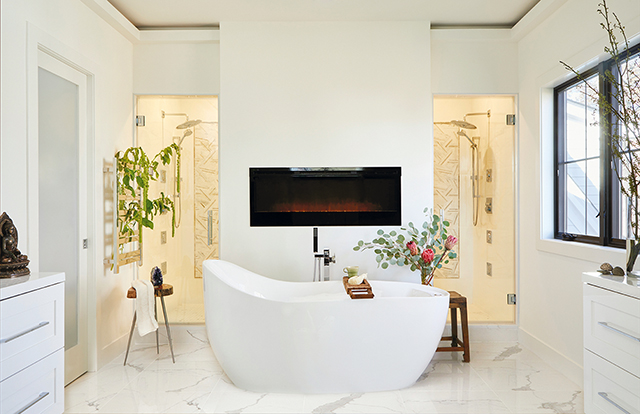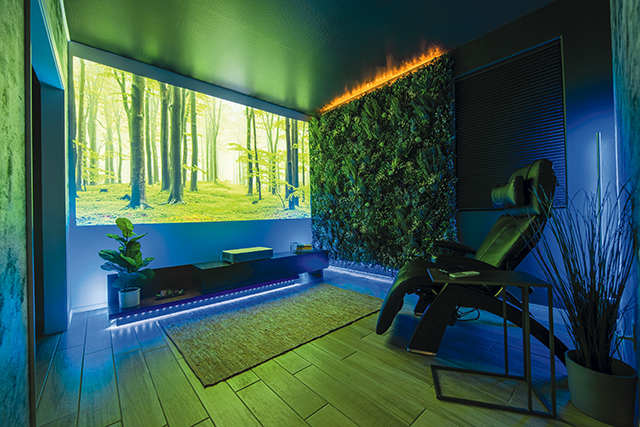Residential wellness design is having a moment – or, you could say, a movement – which is rather unsurprising when people around the world have spent the last year mostly in their homes. Never has the link between housing and health been made more painfully obvious than when an increasingly transmissible, potentially deadly airborne virus has made public life dangerous in a thousand unexpected ways.
Home has become refuge, office, warehouse, gym, assisted-living facility and school room all at once. That has presented both opportunities and challenges and is spurring building and remodeling trends from kitchens to bathrooms and well beyond.
Dark Days Revisited
In its earliest days, before its terrifying ability to infect us through our ventilation systems became known, COVID-19 drove a mysterious toilet paper shortage. Those with bidet functionality were kings and queens of at least their “throne rooms,” if not their entire castles.
“When the pandemic first hit, we saw a demand for bidet seats, either to retrofit on existing or on newly purchased toilets and bidet toilets,” recalls Russ Diamond, president of Santa Monica-based high-end appliance and plumbing retailer Snyder Diamond. “While it was typically viewed as a luxury item, now I think it’s perceived as essential.”
Chest freezers and cleaning wipes also vanished quickly from store aisles. “The ongoing number one request is low maintenance and easy to clean,” comments Seattle designer and college instructor Paula Kennedy. “The number two request has been storage, but today this is increasing exponentially!” she declares. “Now more than ever, people have a freezer in the garage for food storage. And the refrigerator is growing in size, or they are adding produce drawers and beverage refrigerators to save room in the main 36″ refrigerator.”
Also essential was the need for their homes, condos or apartments to do much more at the same time. “The pandemic enhanced our focus on flexible spaces and furnishings that allow people to use their homes more adaptively and effectively,” notes Laurence Carr, a New York City-based designer. “I’m seeing a lot of interest in ‘leisure rooms’ that can flexibly be used as a fitness room, meditation/yoga studio and/or school/office space, as well as sound rooms that convert into movie ‘theaters,’” she shares. “Lately, I’m particularly interested in using smart tech to support sound/audio needs. With so many people living and working under one roof, soundproofing is a very timely issue. For people who cannot rebuild or reinsulate their homes, we can use smart tech to pipe in white noise for instance, to reduce the impact of outside noise and improve concentration.”
“With the initial shock and uncertainty of the virus behind us and society hopefully nearing herd immunity, our cultural norms are being redefined almost on a daily basis,” Diamond suggests. “Priorities have changed and our need for sanctuary is being played out through choices centered around the home. While the idea of incorporating wellness concepts predates the pandemic by a few years, I think the crisis has created a stronger sense of importance and urgency on wellness.”
For the first months of the pandemic, manufacturers and designers around the world paused to handle their teams and challenges, but the months of sequestration drove the need for replacement and upgrade of suddenly harder-working appliances and fixtures, and the urge to improve spaces getting much harder scrutiny. Remodeling rebounded by the end of 2020 and is on track to have a stellar 2021.

Steam showers are definitely trending in bathroom wellness.
Photo: ThermaSol – available at Snyder Diamond
Bed & Bath Wellness
On the luxury end that Snyder Diamond serves, steam showers, saunas (especially infrared), wet rooms, multi-sensory showerheads, horizontal and electronic thermostatic temperature control valves and other related products such as folding seats, decorative grab bars/railing, personal wall-mounted and hand-held bidet shower fixtures, chromotherapy lighting, misting sprays, aromatherapy and barrier-free drains and designs for enhanced accessibility are all selling well.
Diamond, Carr and Kennegdy all see bathroom warmth amenities growing in popularity. “Heated floors and heated towel racks help reduce moisture in this normally small room to reduce germs and mildew build up,” the Seattle designer notes. “They also promote health and wellness with thermal comfort – comfort being a key word these days!”
“For bathtubs, the trend had been focused on free standing soaking tubs, and we are now seeing more companies developing and incorporating whirlpool and air spa options for indoor and outdoor use,” Diamond shares. “Deep soaking, walk-in accessibility, recirculated temperature control and ozone-treated water (micro bubbles to treat various skin conditions) are [being offered], in addition to the more common chromotherapy, aromatherapy and integrated speakers to stream sound via Bluetooth,” he notes, adding a shout-out to flotation tubs and a unique dry-floating hot water mattress.
“The Zerobody offers all the benefits of an immersion tank, but without getting wet or feeling confined in a small space,” he explains. The fixture seems like a way to extend a bath professional’s purview into a bedroom, particularly for a high-end client who wants the wellness benefits of flotation without adding or replacing an existing tub.
“People crave restorative bedrooms, where sleep is the center of the attention,” Carr shares. “Style wise, there’s a new focus on color, pattern and shape to make interiors more visually interesting and personalized with extensive window treatments, wallpaper and elements of decor.”
“If designers aren’t specifying window blinds of some kind, they are providing incomplete plans for their clients,” Kennedy states. “We can’t offer a complete lighting management plan without including window light management as well.” She also sees human centric lighting as part of a wellness bedroom-bathroom suite, she says.

From cork floor to skylight, this compact kitchen from Paula
Kennedy, CMKBD, CLIPP, CACC, is chock full of wellness features.
Photo: Paula Kennedy CMKBD, CLIPP, CACC / Timeless Kitchen Design
Kitchen Wellness
Wellness is about making life simpler and less stressful, Carr notes. “Everything needs to be easy. We are finding innovative ways to make cooking, food prep, composting, etc. simple, sustainable, healthy and fun! Hands-free options such as faucets and trash cans reduce the spread of germs; smart-tech appliances you can interact with from your phone dramatically improve convenience and safety; and water purification, proper lighting, air venting and purification are essential…and, of course, some plant life is a must!”
“I know it’s coming and may even exist in a few appliances already, but I want to walk into the kitchen and tell the oven to preheat to 350 degrees. I want the Jetson’s kitchen today!” Kennedy declares.
Her wish isn’t far off. In the kitchen, Diamond is seeing technology showing up in the wellness realm. “‘Adaptive Cooking Technology’ integrates all cooking processes for optimal sustainability, precision and healthy cooking, which includes recipe discovery, food storage and water and air filtration,” he offers. He’s also seeing strong interest in steam, sous vide, vacuum sealing, flash freezing and slow cooking. Connected coffee and wine dispensers are also popular with his luxury segment.

Outdoor living has become both essential and luxurious, as seen in this design by Laurence Carr, GREEN AP.
Photo: Laurence Carr, Inc. / Kelly Marshall – Photographer
Outdoor Wellness
“The newest lifestyle-enhancing category trending is outdoor kitchens and products,” notes Diamond, who says he’s seeing this among his designer, builder, developer and consumer clientele. This includes interest in outdoor cabinetry, appliances and accessories.
Designers, builders, developers and consumers have been really focused here as people have extended their living spaces into all available outdoor areas and are intent on optimizing them; this is another response to being cooped up during the pandemic. “In the past, our outdoor sales consisted of usually a grill and maybe an undercounter refrigerator. Now we’re selling full kitchens, usually with a full complement of products and accessories like smokers, refrigeration, sinks, faucets, dishwashers, gas burners, pizza ovens, built-in drawers and dry pantry storage, etc. We’ve also seen a huge surge of interest in indoor and outdoor pizza ovens,” Diamond shares.
New Construction
Homebuilding is also surging, with wellness showing up as a prominent selling tool. “Custom homebuilders with influence from the architect and design professional are the biggest proponents of incorporating wellness themes into their designs and products,” Diamond says. “This includes fitness and sanctuary/spa areas in their home bathrooms, and technology and entertainment inclusion in kitchens. We often see dedicated spaces for meditation, exercise rooms, indoor/outdoor lap pools, steam and sauna, salt tanks, cold plunge baths, cryotherapy (cold rooms) and hydrotherapy whirlpools. Separate private bath spaces in the master bath have been a popular design option when space allows.”
Wellness has hit the mainstream, too. Shea Homes, one of the nation’s largest home builders, is advertising its Pure Living package, with features such as air and water filtration and touchless faucets. KB Home, another American builder, has joined the WELL Living Lab Alliance (created by a partnership between the Mayo Clinic and Delos, creator of wellness-related smart home systems) to create a wellness concept home in Arizona. This project, inspired by WLL’s Healthy Home Program, was in development before the pandemic, but with more potential homebuyers now spending time online focused on their health, and the concept home’s virtual tours being available globally, it couldn’t have been better timed.
“The overall objective was to educate customers and select new-home products offered by WLL Alliance members that were available today,” shares Dan Bridleman, a senior v.p. with the builder. Features from the WLL program include smart devices to address health and sleep; wellness spaces with immersive audio and video to enhance mood, energy and performance; technologies designed to reduce virus transmission, and home offices with ergonomic features. The concept home isn’t available for sale yet, but definitely shares the many aspects and benefits of a wellness home. By the time it does hit the market, there will likely be more features available.
Predictions
“I think we can expect some pretty exciting technologies,” Diamond predicts. “This might include handprint scanners that can measure your weight, body fat composition, heart rate and cholesterol and sugar levels,” pointing to the health monitor features already designed into our smart phones as a natural segue to kitchen and bathroom wellness tech.
He also points to global manufacturers including Duravit and Toto that are already developing toilets that analyze bodily waste to detect early disease. “These health monitors could become regular features, providing real-time health and fitness analytics for each member of the home. Imagine your toilet providing you with an early diagnosis of disease!”
If this seems far-fetched, know that early COVID spread is already being detected with wastewater analysis by public health researchers. “These toilets may even be smart enough to recommend appropriate diets based on body type and activity planned for the day,” Diamond asserts.
“Finding peace of mind in the midst of the global pandemic has become important, which means people have wanted to make sure their homes and living spaces feel like highly functional and comfortable sanctuaries,” the retailer shares. “Promoting good physical and mental health was already part of the core messaging strategy for wellness-focused brands that we offer. However, we’ve seen appliance brand leaders putting more emphasis on the importance of food safety and preservation and making home feel like a ‘safe space,’ knowing that’s where most folks have spent the majority of their time throughout the health crisis.
“Wellness Design can be an overwhelming category; it touches every part of the home and every part of how we interact with our surroundings,” Kennedy observes. “Wholistic is really the only method of approach we can take.” ▪


